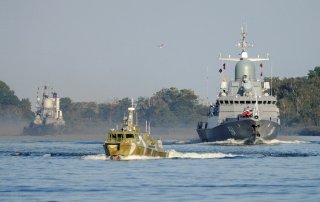Can the U.S. Navy Take Lessons from Sci-fi Television?
StarTrek and Battlestar Galactica may have some interesting insights.
“Redundancy” is the traditional antidote for battle damage and other emergencies. It imparts resiliency to a combat unit. In hardware terms, redundancy means furnishing a spare of everything you can—shipwrights installing duplicate machinery so that a vessel has an extra generator, pump, piping system, whatever. Lose one widget, and you put a duplicate in service. Excess capacity thus lets crews reroute around damage. It lets a unit sustain its fighting strength despite absorbing a pounding. Spare manpower serves the same purpose. It provides skippers replacements for those who fall in action. Individuals may be incapacitated; the ship as a whole fights on.
If you’re China and confront an antagonist that opts to do without redundancy, you can deploy a troublemaking strategy. You whittle away at the center of gravity manifest in minimal manning. The object of such a strategy? Tire and bewilder crews that may already be overworked. Fling a variety of challenges at them, along as many axes as you can, as simultaneously as you can. Give each crewman more to do than he can, on the Cylon-esque reasoning that imposing numerous, repeated contingencies compounds the demands on people and hardware. Such tactics constitute the precursor to a crushing blow—or to an American withdrawal under duress.
China’s navy, in short, could ape the Cylons’ strategy. In purely martial terms, posing missile, gun, and torpedo threats from many points of the compass from as many domains as possible—from the surface, the depths, and aloft—would compel a ship’s beleaguered defenders to cope with more challenges, perhaps, than they could manage. Flooding an embattled zone with China Coast Guard vessels, fishing craft, and purportedly civilian sea and air traffic—interspersing combat units among nonmilitary ships and planes—would further complicate U.S. commanders’ picture of the surroundings. It would be hard to act for fear of hitting the wrong target—and having pictures of an errant shot splashed across TV and computer screens around the world.
That’s a fate few captains relish. And Chinese commanders would doubtless deploy deceptive measures to make the campaign even more wearisome. To glimpse the People’s Liberation Army (PLA) mindset toward deception, dust off that old copy of Sun Tzu’s Art of War. Among other things, Book I of the Chinese masterwork instructs generals to “feign disorder,” “feign incapacity,” sow confusion among the enemy leadership, divide an enemy host and fall on the weaker fractions, and generally deploy “normal” and “extraordinary” forces in mercurial combinations to confound and weaken opponents. Such ideas find their way into contemporary works on PLA strategy.
Do all that, and a weaker but resolute China stands some chance of overcoming its brawnier foe. It could land a heavy hit or, failing that, simply outlast the foe. How to respond? First and foremost, the U.S. Navy should acknowledge—should grok, as sci-fi master Robert Heinlein might say—that a manpower deficit represents a grave weakness in a hot war. Taking the problem seriously constitutes the first step toward a solution.
Second, it should conscript some imaginative tacticians to play the “red team,” projecting how PLA forces might harness troublemaking strategies. Realistic wargames illuminate the contours of problems while hinting at workarounds.
Third, there may be no substitute for stationing sailors aboard American surface combatants in greater numbers. The service leadership already expanded the crew of littoral combat ships by 25 percent. That’s a welcome boost in percentage terms, but a 25 percent boost equates to just ten more seafarers. Exercises will show how many more mariners are needed, and what skills they should boast to bolster these vessels’ resiliency.
And lastly, the nation is poised to undergo a change of presidential administrations that will usher in a president inclinedto bulk up the U.S. Navy, along with a secretary of the navy reportedly inclined to agree. The next few months, then, represent the ideal time for the navy leadership to put the case for new policies—including less minimal manning—before a political leadership favorably disposed toward such policies.
Let’s hand them a sci-fi tract while we’re at it. Therein lies wisdom.
James Holmes is professor of strategy at the Naval War College and coauthor of Red Star over the Pacific (second edition forthcoming 2018). The views voiced here are his alone. This first appeared earlier and is being reposted due to reader interest.
This article is being republished due to readers' interests.
Image: Reuters

